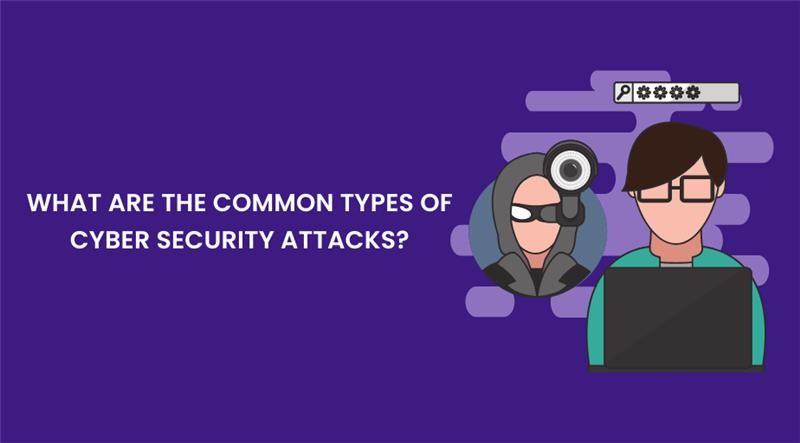

The frequency of Cyber Security Attacks has been steadily increasing in recent years, with new attacks being reported daily. This is due in part to the growing reliance on technology and the increasing amount of sensitive information being stored online. Some estimates suggest that there are millions of attempted cyber-attacks every day.
Hence, individuals and organisations attach significant importance to Cyber Security Courses to protect themselves from these attacks. This blog will further cover various topics such as types, purpose, and frequency of Cybersecurity attacks.
Table of Content
Types of Cyber Security Attacks
There are diverse types of Cyber Security Attacks that can target individuals, businesses, and organisations. Here are some common types:
Malware: Malware, also called malicious software, is any program or code intentionally created to harm or compromise the security of a computer system. This can include trojans, worms, viruses, ransomware, and spyware.
Phishing: Phishing attacks use social engineering tactics to trick people into sharing confidential information like personal information include login credentials, credit card numbers, and other sensitive data. These attacks often come in the form of emails or fake websites that look legitimate.
Denial of Service (DoS) attacks: A DoS (Denial of Service) attack intends to inundate a network or server with an excessive amount of traffic, rendering it unattainable for legitimate users to access. This can be done through a variety of means, such as flooding the network with traffic or exploiting vulnerabilities in network protocols.
Man-in-the-middle (MITM) attacks: In a MITM attack, an attacker intercepts communication between two parties to eavesdrop on their conversation or steal sensitive information. This can be done by compromising a network or by creating a fake network that appears legitimate.
SQL injection attacks: SQL injection attacks target databases by exploiting vulnerabilities in web applications that use SQL databases. Malicious individuals can insert harmful code into SQL queries, which can then give them unauthorised access to or the ability to change important data.
Zero-day attacks: A zero-day attack exploits a vulnerability in software that is not yet known or has not yet been patched. This can be a particularly dangerous type of attack, as it can give an attacker full access to a system without the victim even knowing it has been compromised.
These are just a few examples of the many types of Cyber Security Attacks that exist. It’s important to stay vigilant and take steps to protect yourself and your organisation from these and other threats.
Effective new account fraud detection is paramount in safeguarding financial systems. Implementing advanced algorithms and behavioral analytics helps swiftly identify suspicious patterns during account creation. Explore the importance of robust new account fraud detection systems to fortify your security measures.
Purpose of Cyber Security Attacks
The purpose of Cybersecurity attacks can vary widely depending on the attacker and their motivations. Here are a few common reasons why cyber-attacks occur:
Financial gain: Many cyber-attacks are carried out to steal money or valuable data. This can include stealing credit card information, ransomware attacks, or theft of intellectual property.
Espionage: Some cyber-attacks are carried out by nation-states or other organisations to spy on other countries or companies. This can include stealing sensitive information or disrupting critical infrastructure.
Hacktivism: Hacktivists are individuals or groups that carry out cyber-attacks as a form of political or social activism. These attacks may be aimed at government or corporate targets to draw attention to a cause.
Cyber warfare: In some cases, cyber-attacks may be part of a larger military conflict or act of aggression. Nation-states may carry out cyber-attacks against one another in order to disrupt communication or cause damage to critical infrastructure.
Launch and Frequency of Cyber Security Attacks
The launch and frequency of Cyber Security Attacks can vary widely depending on the attacker, their goals, and the vulnerabilities they are targeting. Here are some factors that can affect the frequency and intensity of cyber-attacks:
Technology advancements: As technology advances, so do the methods and tools used by attackers. This can lead to more sophisticated and frequent attacks.
Availability of exploit kits: Exploit kits are collections of tools used to carry out attacks. When new exploit kits are released or existing kits are updated, this can lead to a surge in Cybersecurity attacks.
Growing number of targets: With more businesses, individuals, and devices connected to the internet, there are more potential targets for attackers. This can lead to an increase in the frequency of attacks.
Motivation of attackers: As mentioned earlier, attackers may be motivated by financial gain, espionage, hacktivism, or cyber warfare. The frequency of attacks may increase if there is a significant opportunity for the attacker to achieve their goal.
Political or social events: Cyber-attacks may also increase in frequency during political or social events, such as elections or protests, as attackers seek to take advantage of the chaos or draw attention to their cause.
Conclusion
Overall, the frequency of Cyber Security Attacks is increasing, with new attacks being launched every day. Organisations and individuals should take steps to protect themselves, such as implementing strong security measures, keeping software up-to-date, and staying informed about the latest threats.
When it comes to keeping your home comfortable while minimizing energy costs, the roofing material…
Ensuring optimal comfort in your home hinges largely on the reliability of your air conditioning…
In the evolving landscape of childcare, families are increasingly faced with the challenge of securing…
In Ontario, Silverback Steam Boilers & Heating Rentals distinguishes itself as a premier provider of…
When planning luxury networking events, selecting the right venue is pivotal. An ideal location not…
In considering ways to engage deeply with the splendor of the great outdoors, few activities…